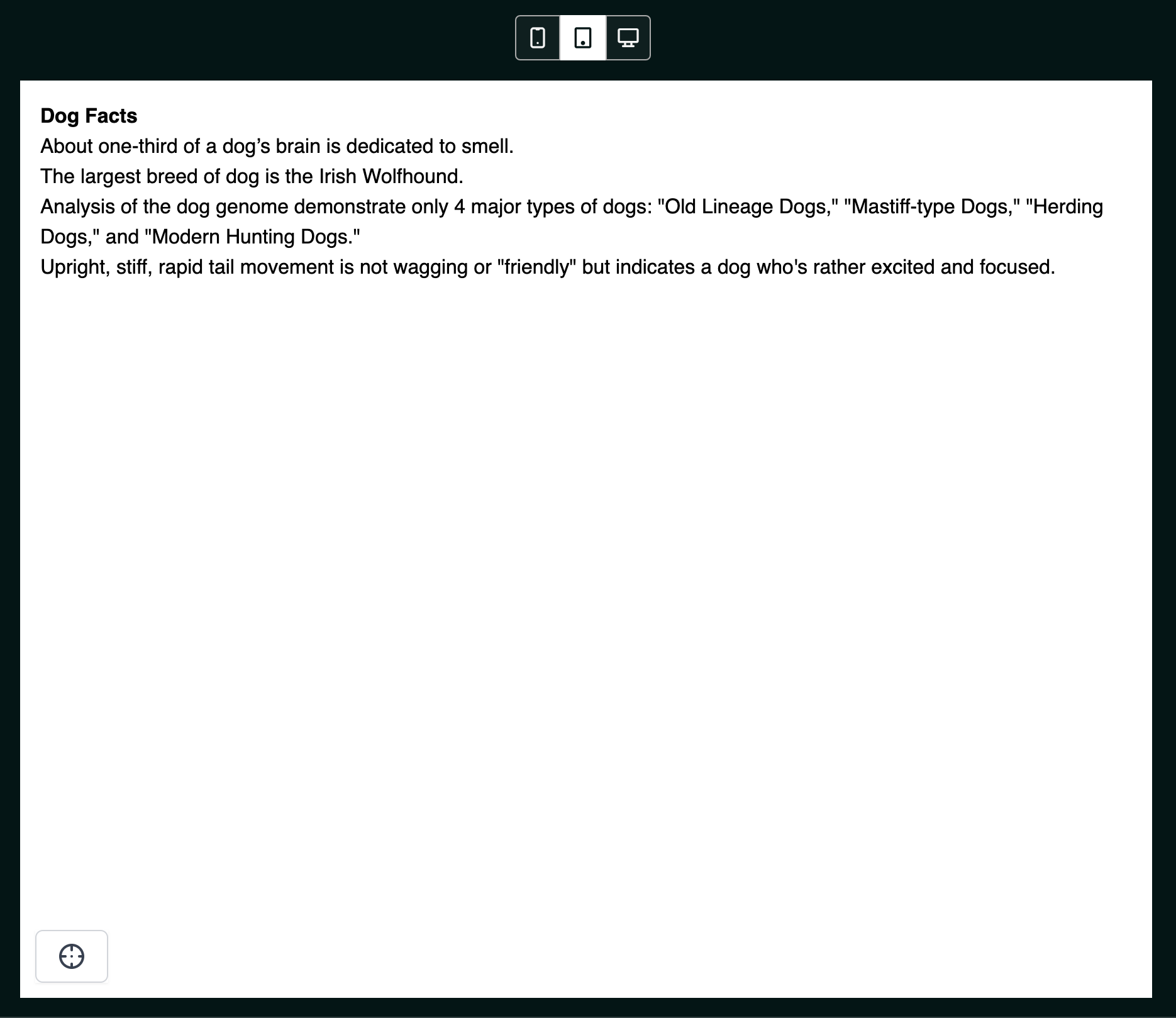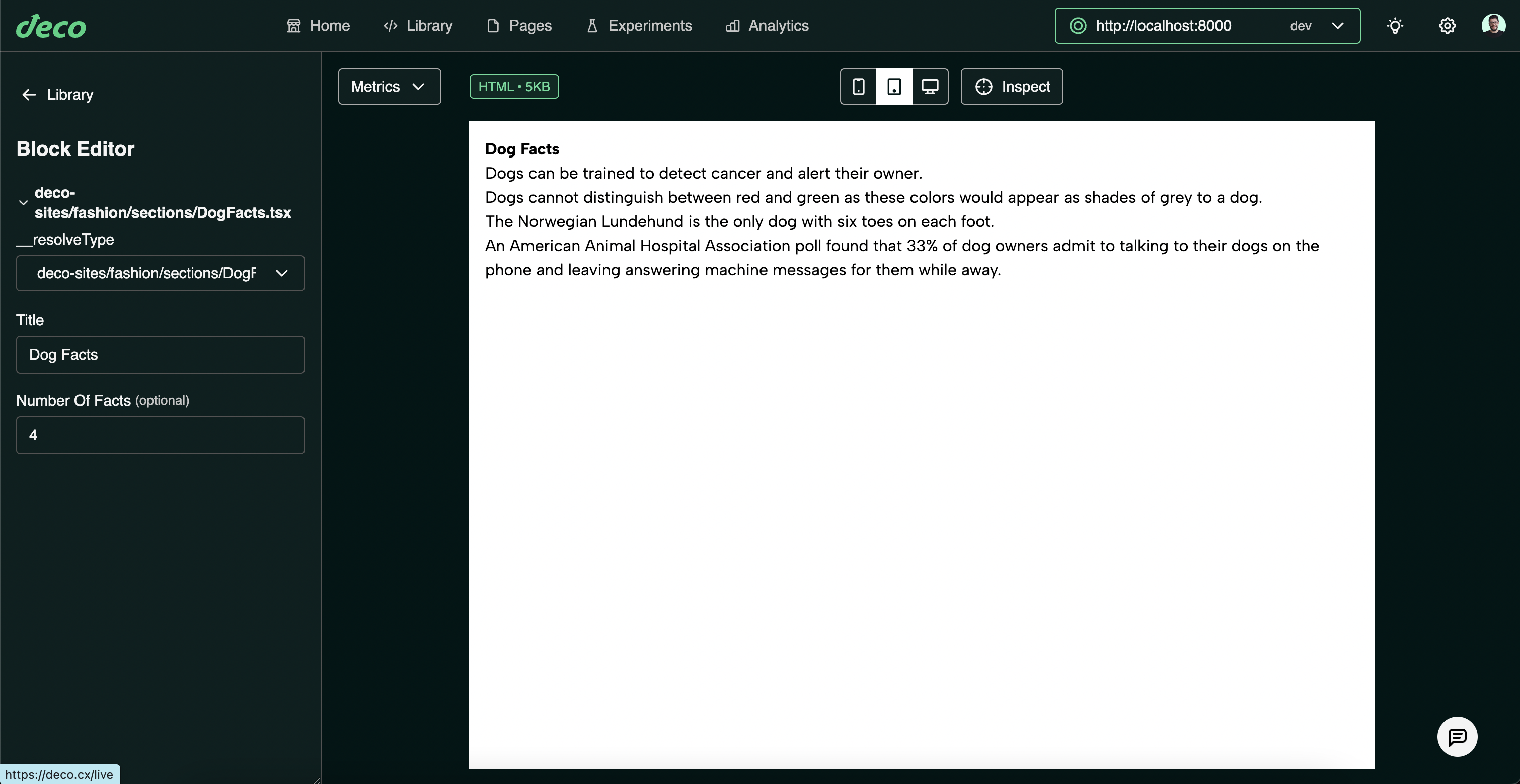Suggested reading
Fetching data is a common requirement when building websites or applications.
deco.cx provides a data-fetching solution that loads data on the
server-side and is flexible enough to allow business users to customize how
data is fetched, just how they can configure Section's props.
In this tutorial you'll learn how to fetch data from an external API and feed that into a Section using Loaders.
What we'll build
The example use-case we'll follow is simple, but it has a lot of complexities we have on data fetching:
- Fetch dog facts data from the Dog API allowing the user to configure how many facts are being fetched on deco.cx's Admin.
- Render those facts in a Section.

Preview of DogFacts Section showing data returned from API

Data returned from the Dog Facts API being called elsewhere
Creating the Section
If we make an HTTP request to the Dog Fact API, we will see that it returns a JSON in the following format:
Open in your browser: https://dogapi.dog/api/facts?number=1
{
"facts": [
"The Labrador is so popular, in 2006 there were approximately 3-5 times more Labs as there were German Shepherds or Golden Retrievers."
],
"success": true
}Note that the only thing we care about is the "facts" property. Therefore, we will create a section that is prepared to receive these facts and render them in any way we want.
To do this, we will create a type called DogFact that contains only one property called fact, which is the string represented by the message.
Let's see this in action by creating a new section:
- Create the DogFacts.tsx section in the sections/ folder of your project.
- Paste the following code:
export interface DogFact {
fact: string;
}
export interface Props {
title: string;
dogFacts: string[];
}
export default function DogFacts({ title, dogFacts }: Props) {
return (
<div class="p-4">
<h1 class="font-bold">{title}</h1>
<ul>
{dogFacts.map((fact) => <li>{fact}</li>)}
</ul>
</div>
);
}At this point, we can run
deno task startand check in our admin that this component can already be used with static data, which doesn't make much sense for our use case.
Creating the Loader and testing the Section
Loaders allow you to define how data is fetched and transformed before it is
passed on to a Section. They are regular Typescript functions that can use
async functions like fetch. Loaders can be "plugged" into a Section via one
the Section's props, and that happens based on the return type of the
Loader.
- Define what will be the input
Propsof your loader. - Export a function called
loaderin the same file as your Section.
import type { SectionProps } from "deco/mod.ts";
// Props type that will be configured in deco.cx's Admin
export interface Props {
title: string;
numberOfFacts?: number;
}
export async function loader(
{ numberOfFacts, title }: Props,
_req: Request,
) {
const { facts: dogFacts } = (await fetch(
`https://dogapi.dog/api/facts?number=${numberOfFacts ?? 1}`,
).then((r) => r.json())) as { facts: string[] };
return { dogFacts, title };
}
export default function DogFacts(
{ title, dogFacts }: SectionProps<typeof loader>,
) {
return (
<div class="p-4">
<h1 class="font-bold">{title}</h1>
<ul>
{dogFacts.map((fact) => <li>{fact}</li>)}
</ul>
</div>
);
}- Run
deno task startif you haven't already done so. - Assuming that
deno task startis running, go tohttps://deco.cx/adminand select your Site. - Make sure that
localhost:8000is selected in the Environment Selector in the upper right corner of the Admin. - Go to
Libraryand search for DogFacts in the left sidebar. - Configure the props of the selected Loader (numberOfFacts) with a desired number (e.g., 4).
Now, let's see it working hooking it up with a Section.

Library showing the DogFacts Section rendering data fetched from the API
It's also possible to create a new
proploaded from a new loader in an existing Section.
That's it! Now you've built a Section that displays data fetched from an
external API using a Loader, making it all configurable by business users as
desired. We recommend exporting filters and sort options in Loader's props to
make it more reusable in deco.cx's Admin.
Further reading
Loaders are powerful components for handling dynamic data and solve most of the requirements when dealing with data coming from APIs. The deco.cx platform solves a myriad of other use cases related to dynamic data that we can use, check the following links to understand how to use them.